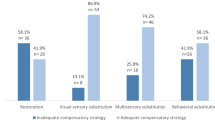Abstract
The ocular counterrolling can be static or dynamic. The purpose of this work is to connect the clinical absence of dynamic ocular counterrolling with bilateral caloric paresis. A prospective study on 216 patients in whom the absence of dynamic ocular counterrolling was tested and standard caloric test was performed. The cut-off value for bilateral caloric paresis is an absolute reflectivity of 10 in nystagmic frequency and 8 in slow phase velocity. The adequate contingency tables were constructed and tests of Chi-squared calculated. Sensitivity, specificity, positive and negative predictive values, positive and negative likelihood ratios, and area under receiver operating characteristic (ROC) curve were also calculated. Using the reflectivity according to the nystagmic frequency, we obtained P = 0.000 for Chi-squared, area under ROC curve was 0.832 and positive likelihood ratio 11.47. For slow-phase velocity, the results were P = 0.000, area ROC of 0.735 and positive likelihood ratio 9.43. There is a statistically significant connection between the clinical absence of dynamic ocular counterrolling and bilateral caloric paresis, with a strong diagnostic power. The mechanisms by which this phenomenon can be attributed to canalicular damage instead of otolithic damage are discussed.


Similar content being viewed by others
References
Leigh RJ, Zee DS (2006) The vestibular-optokinetic system. In: Leigh RJ, Zee DS (eds) The neurology of eye movements, 4th edn. Oxford University Press Inc, Oxford, pp 20–108
Roman S, Thomassin JM (2000) Physiologie vestibulaire (Encycl Med Chir Oto-rhino-laryngologie 20-198-A-10. Editions Scientifiques et Médicales Elsevier SAS, Paris, 14 p
Simonsz HJ (1985) The history of scientific elucidation of ocular counterrolling. Doc Ophthalmol 61:183–189
Bárány R (1906) Über die vom Ohrlabyrinth ausgelöste Gegenrollung der Augen bei Normalhörenden, Ohrenkranken und Taubstummen. Arch Ohrenheilkd 68:1–30
Bárány R (1925) Verbesserter Apparat zur Untersuchung der Gegenrollung der Augen und des Nystagmus. Acta Otolaryngol 8(1):25–44
Miller EF (1962) Counterrolling of the human eyes produced by head tilt with respect to gravity. Acta Otolaryngol 54:479–501
Howard IP, Evans JA (1963) The measurement of the eye torsion. Vision Res 3:447–455
Hatamian M, Anderson DJ (1983) Design considerations for a real-time ocular counterroll instrument. IEEE Trans Biomed Eng 30:278–288
Aubry M, Pialoux P (1957) L’examen labyrinthique. In: Aubry M, Pialoux P (eds) Maladies de l’oreille interne et oto-neurologie. Masson et Cie, editeurs, Paris, pp 144–145
Brandt T (1991) Bilateral vestibular loss. In: Brandt T (ed) Vertigo. Its multisensory syndromes. Springer, London, pp 77–81
Brandt T, Dieterich M, Strupp M (2005) Bilateral vestibulopathy. In: Brandt T, Dieterich M, Strupp M (eds) Vertigo and dizziness. Common complaints. Springer, London, pp 75–81
Herdman SJ, Hall CD, Schubert MC, Das VE, Tusa RJ (2007) Recovery of dynamic visual acuity in bilateral vestibular hypofunction. Arch Otolaryngol Head Neck Surg 133:383–389
Schubert MC, Tusa RJ, Grine LE, Herdman SJ (2004) Optimizing the sensitivity of the head thrust test for identifying vestibular hypofunction. Phys Ther 84:151–158
Sección de Otoneurología de la SEORL (2001) Síndrome vestibular bilateral. Criterios diagnósticos. Acta Otorrinolaringol Esp 52:645–648
Pita Fernández S, Pértegas S (2003) Pruebas diagnósticas. Cad Aten Primaria 10:120–124. Actualización 14 July 2003. Available in at: http://www.fisterra.com/mbe/investiga/pruebas_diagnosticas/pruebas_diagnosticas2.pdf. Accessed on 24 July 2008
Jaeschke R, Guyatt GH, Sackett DL and The Evidence Based Medicine Working Group (2007) How to use an article about a diagnostic test. Centre for Health Evidence. Available at: http://www.cche.net/usersguides/diagnosis.asp. Accessed on 24 July 2008
López de Ullibarri Galparsoro I, Pita Fernández S (1998) Curvas ROC. Cad Aten Primaria 5:229–235. Actualización 25 September 2001. Available at: http://www.fisterra.com/mbe/investiga/curvas_roc/curvas_roc2.pdf. Accessed on 24 July 2008
Miller EF, Graybiel A (1963) A comparison of ocular counterrolling movements between normal persons and deaf subjects with bilateral labyrinthine defects. Ann Otol Rhinol Laryngol 72:885–893
Markam CH, Diamond SG (2001) Ocular counterrolling differs in dynamic and static stimulation. Acta Otolaryngol Suppl 545:97–100
Jampel RS, Shi DX (2002) The absence of so-called compensatory ocular countertorsion: the response of the eyes to head tilt. Arch Ophthalmol 120:1331–1340
Markham CH, Diamond SG (2002–2003) Ocular counterrolling in response to static and dynamic tilting: implications for human otolith function. J Vestib Res 12:127–134
Pansell T, Tribukait A, Bolzani R, Schworm HD, Ygge J (2005) Drift in ocular counterrolling during static head tilt. Ann NY Acad Sci 1039:554–557
Cheung BS, Monkey K, Howard I, Kirienko N, Johnson W, Lackner J, Dizio P, Evanoff J (1992) Human ocular torsion during parabolic flights: an analysis with scleral search coil. Exp Brain Res 90:180–188
Sauvage JP, Puyraud S, Roche O, Rahman A (1999) Anatomie de l’oreille interne (Encycl Méd Chir Oto-rhino-laryngologie 20–020-A-10). Editions Scientifiques et Médicalen Elsevier SAS, Paris 16 p
Author information
Authors and Affiliations
Corresponding author
Rights and permissions
About this article
Cite this article
Oliva Dominguez, M., Bartual Magro, J. & Bartual Pastor, J. Ocular counterrolling: an indicator of bilateral vestibulopathy. Eur Arch Otorhinolaryngol 267, 345–350 (2010). https://doi.org/10.1007/s00405-009-1043-3
Received:
Accepted:
Published:
Issue Date:
DOI: https://doi.org/10.1007/s00405-009-1043-3




